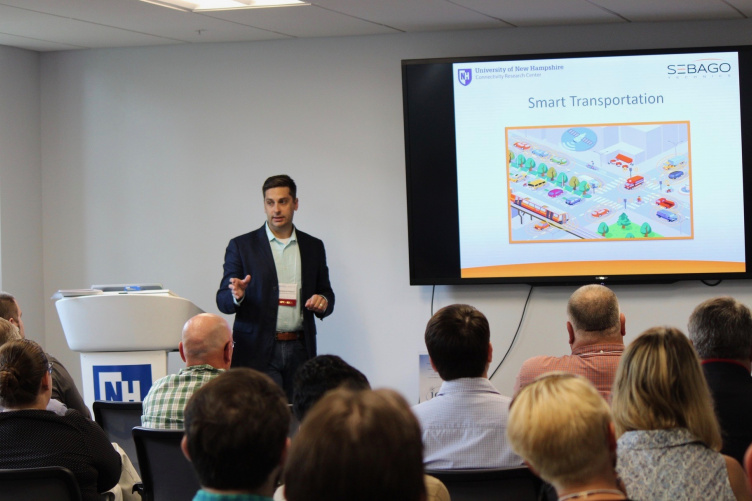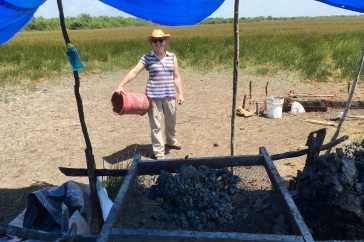
Nicholas Kirsch, founding director of the Connectivity Research Center, discusses connected vehicle technology during a recent presentation on networking traffic lights.
The notion that driverless cars will make us all safer doesn’t stand alone; connected vehicle technology — the communication between cars and their surroundings about such things as traffic accidents and construction delays— is an integral part of that mission.
At UNH, the Connectivity Research Center (CRC) has been working with the New Hampshire Department of Transportation and its traffic consultant, Sebago Technics, Inc., to test networking sensors that allow traffic lights and vehicles to talk to each other.
“This project establishes UNH and the CRC as thought leaders in connected vehicle research in New England via the vehicle to infrastructure (V2I) testbed.”
Here’s how that could work: A car idling at a red light could find out when the light would change. Or, or an approaching vehicle could learn the signal’s status before reaching the intersection, helping drivers make decisions about speed, for example, which could benefit the environment.
Sebago chose three busy Dover intersections as pilot sites. Dover is the only city in the state currently set to test the traffic data technology.
“The main purpose of the technology is safety and better traffic management; the environmental aspect is a bonus,” says Christina Dube, research program manager with the CRC. Of the center’s involvement with the project, she says, “We had the understanding of the technology and how to implement it. One of the things we did was write a software application that could decode the information the car 'heard' and present it in a human readable format.”
Computer engineering majors Justin Paquette ’19 and Ethan Wamsley ’19 wrote the app that will have traffic lights communicating with drivers via dedicated short-range communications (DSRC) radios and cellular devices. “We had to figure out how to get the pieces of technology to talk so they could get the job done,” Paquette says. “That was a little bit of a challenge, to get the radios to talk to each other.”
The joint project is in response to the SPaT (signal phasing and timing) Challenge issued by the standards-setting group American Association of State Highway and Transportation Officials that calls for all 50 states to have DSRC infrastructure in place on at least one traffic corridor by January 2020.
Meanwhile, automakers like Audi and General Motors have already started building the vehicle-to-vehicle technology into their cars. And select intersections in Washington, D.C., Dallas and Houston and Denver, among others, have the signal infrastructure in place to talk to those cars.
“This project establishes UNH and the CRC as thought leaders in connected vehicle research in New England via the vehicle to infrastructure (V2I) testbed,” says Nicholas Kirsch, associate professor of electrical and computer engineering and founding director of the Connectivity Research Center. “It also provides avenues for future deployment of V2I infrastructure as well as a platform for autonomous vehicle research and creates opportunities for student research projects.”
Kirsch lauds the venture for launching the partnership with Sebago Technics. Additionally, the connected vehicle technology project paves the way for further collaborations with industry radio and infrastructure manufacturers as well as state agencies such as the Vermont Agency of Transportation and the Maine Department of Transportation. Public policy, economics, data analytics and other engineering and science disciplines offer future potential research areas, Kirsch says.
At a recent demonstration with state and local officials at the UNH InterOperability Lab, where CRC research is conducted, Steve Sawyer of Sebago Technics told the group, “A lot of what we’re doing hasn’t been done here before — this is the only place in New England that it’s being tested. Connected vehicles are coming sooner that we may think.”
A field test at the Dover intersections will take place in October.
See where a career in electrical and computer engineering can take you.
-
Written By:
Jody Record ’95 | Communications and Public Affairs | jody.record@unh.edu

















































